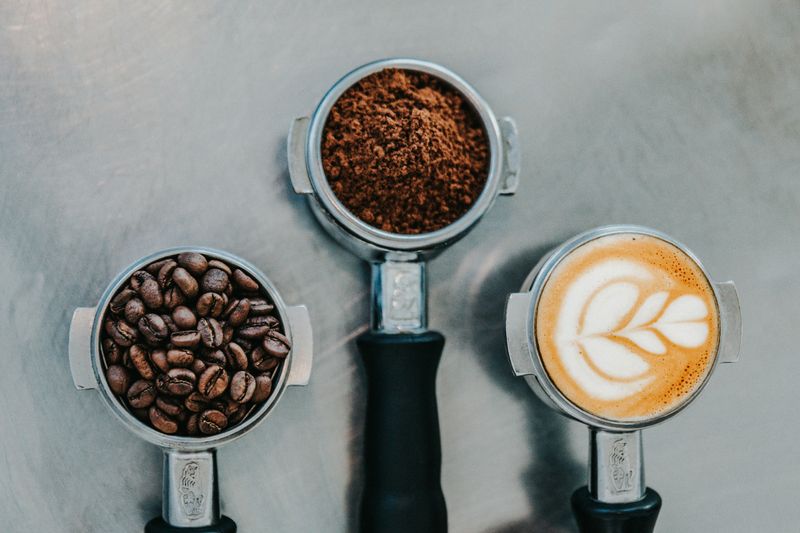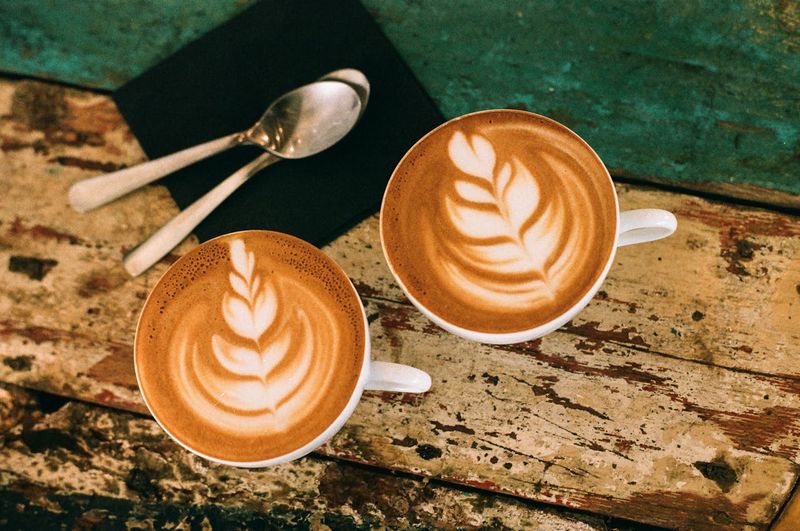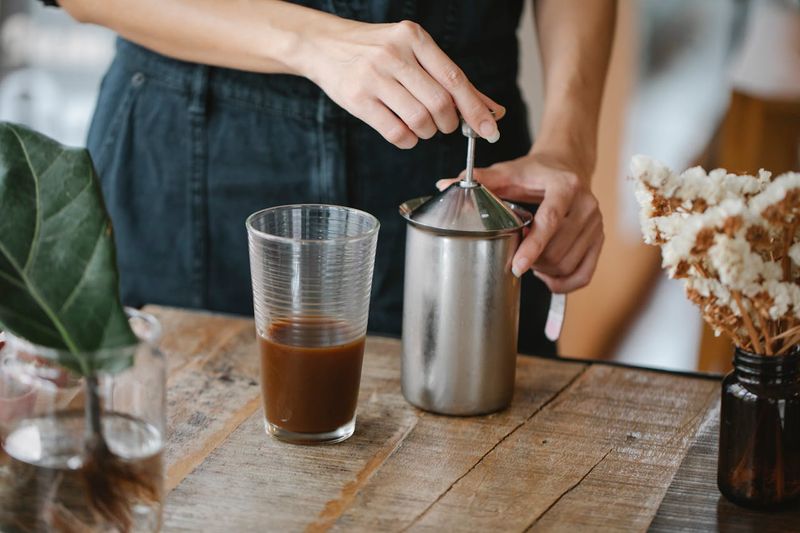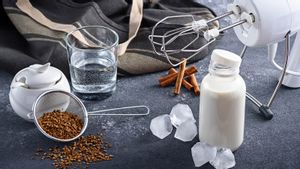Have you ever stood at your favourite coffee shop, staring at the menu and wondering whether to order a cappuccino or a latte? Both sound deliciously comforting, right? But what sets them apart? Let’s wander through the frothy details of cappuccino vs latte and uncover their unique charms. Grab your favourite mug; this might just change your next coffee order!
How Cappuccino is different from Latte?
Milk texture and ratio

When discussing cappuccino vs latte, milk plays a pivotal role. A cappuccino is typically made with equal parts of espresso, steamed milk, and frothed milk. This gives it a creamy yet airy texture with a strong coffee flavour. The froth on a cappuccino is substantial, holding up a spoonful of sugar briefly before sinking.
On the other hand, a latte consists of espresso with a greater amount of steamed milk and only a light layer of froth. This makes the latte creamier and milkier compared to the cappuccino, which is perfect for those who enjoy a milder coffee flavour.
Process of making

The process of making these drinks highlights another aspect of the cappuccino vs latte discussion. For a cappuccino, the key is achieving the perfect balance of the three layers. The espresso is poured first, followed by the steamed milk, and topped with a generous amount of milk foam. In contrast, when making a latte, the focus is on gently integrating the espresso with a lot of steamed milk, topped off with just a touch of foam.
Filtration and coffee-base

The journey of understanding the cappuccino vs latte difference starts with their base—espresso. Both cappuccino and latte are made from espresso, which is a concentrated coffee brewed by forcing hot water through finely ground coffee beans. However, the filtration process and the ratio of espresso to milk vary, which is crucial in distinguishing cappuccino from latte.
Severing

In the cappuccino vs latte debate, even the serving style matters. Cappuccinos are usually served in smaller cups which helps maintain the temperature and the foam’s integrity. Lattes are served in larger, wider cups which makes them ideal for latte art due to the larger surface area.
Impact of Cappuccino vs Latte on health

When evaluating the impact of cappuccino vs latte on health, it’s essential to consider their components. Both drinks have coffee as their base, providing a good source of antioxidants. However, the milk content and therefore, the calorie count, differ significantly.
A typical cappuccino has less milk than a latte, resulting in fewer calories. This might make cappuccino a better choice for those monitoring their calorie intake. Lattes, with their higher milk content, provide more calcium and protein. The choice between cappuccino vs latte might also depend on your dietary preferences or restrictions, such as opting for plant-based milk alternatives.
Cappuccino vs Latte: How to choose between two?

A cappuccino, with its robust espresso flavour and invigorating foam, is ideal for starting your day with a punch. Lattes, on the other hand, are perfect for leisurely afternoons or whenever you crave something a bit more subdued and creamy.
Cappuccinos, with their intense taste and lighter liquid ratio, pair wonderfully with sweet pastries or breakfast items. Lattes, being milder, can complement or smoothly follow a dessert without overpowering it.
Origins of Cappuccino vs Latte

The stories behind the cappuccino and the latte add an interesting layer to the cappuccino vs latte debate, showing how culture and history shape our coffee experiences.
Origin of Cappuccino
The cappuccino has its roots in Italy with a history that dates back to the early 20th century. The name Cappuccino comes from the Capuchin friars, referencing the colour of their robes. The original concept was simple — espresso mixed with steamed milk to create a beverage that matched the Capuchin robe's colour. It gained popularity in Europe as a morning drink and was typically consumed only before 11 AM. Italian immigrants later brought the cappuccino to America and other parts of the world, where it evolved into the frothy delight enjoyed today.
Origin of Latte
The latte, short for caffè latte which means milk coffee in Italian, also originated in Italy, but its widespread adoption as a breakfast drink is a relatively recent phenomenon. In traditional Italian culture, caffè latte was a home-brewed beverage enjoyed primarily at breakfast. It consisted of a strong shot of espresso poured into a cup of hot milk. Unlike the cappuccino, which was crafted by baristas in cafes, the caffè latte was typically made at home and wasn't as meticulously styled as the cappuccino.
It wasn't until the latte was introduced to the American coffee scene in the 1980s that it became commercialised and popularised as the latte we know today. This American version is generally larger and has a higher milk-to-coffee ratio compared to its Italian predecessor. The transformation into a popular café offering allowed the latte to develop a distinct identity, often serving as a canvas for the now-famous latte art due to its larger milk content.
How to make Cappuccino?

Ingredients
- Espresso
- Milk (whole milk works best for frothing)
Equipment
- Espresso machine
- Milk frother or steam wand
Recipe
- Brew the espresso: Start by brewing a shot of espresso into a small cup. If using an espresso machine, follow the manufacturer's instructions for pulling a shot.
- Froth the milk: While the espresso is brewing, steam the milk. For a cappuccino, you'll want to create a lot of froth. Use the steam wand to introduce as much air as possible until the milk has roughly doubled in volume and has a creamy, frothy texture.
- Assemble the Cappuccino: Pour the frothed milk directly over the brewed espresso. Aim for a ratio of roughly one-third espresso, one-third steamed milk, and one-third milk foam. The foam should be thick enough to momentarily support a small amount of sugar before sinking.
How to make Latte?

Ingredients
- Espresso
- Milk (again, whole milk is preferred)
Equipment
- Espresso machine
- Milk frother or steam wand
Steps
- Brew the espresso: Brew one or two shots of espresso directly into a larger, wider cup. The amount of espresso can be adjusted based on how strong you prefer your latte.
- Steam the milk: Heat the milk using the steam wand, but unlike with the cappuccino, you want to create less foam. Focus on just heating the milk and creating a small amount of froth at the top. The goal is to have about a quarter inch of foam.
- Assemble the Latte: Pour the steamed milk into the cup with the espresso, holding back the foam with a spoon until the cup is almost full, then top it off with the remaining foam. The final ratio should be about one part espresso to three parts milk, topped with a little foam.
Tips for both drinks
- Grind quality: Use freshly ground coffee beans for the best flavour. The grind should be fine, as it is suited for espresso.
Milk temperature: When steaming milk, aim for a temperature of around 150°F to 155°F. Overheating the milk can scald it, which affects the taste and quality of the foam. - Clean equipment: Always start with a clean espresso machine and steam wand to avoid off-flavours.
The main differences between making a cappuccino and a latte lie in the milk-to-coffee ratio and the amount of milk foam. Cappuccinos have more foam and are stronger in flavour due to the higher proportion of coffee to milk, while lattes are creamier and milder due to the higher proportion of steamed milk to coffee. Each has its charm and appeals to different taste preferences. Whether you’re in the mood for the boldness of a cappuccino or the smoothness of a latte, both drinks offer a rich and satisfying coffee experience.




